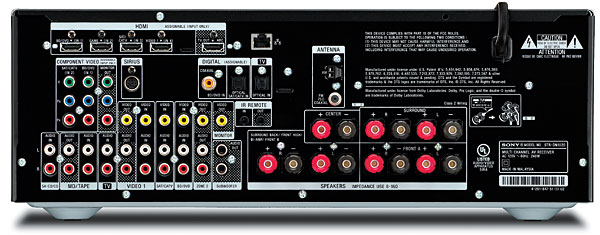Sony STR-DN1020 A/V Receiver

There are two hard-wired options for integrating content from an iPod or iPhone into a receiver-based home theater system. The A/V receiver might have a Made for iPod–compatible USB jack, allowing you to plug the device right into the front or back panel. Or the iPod can fit into an accessory dock. But wouldn’t it be great to have both options?
That’s just what you’ll have if you buy the Sony STR-DN1020 A/V receiver. When I unpacked it, what a pleasant surprise it was to find the dock there in the box, supplied with the product, gratis—no extra expenditure of a hundred bucks or so required. A non-Apple USB cable is also supplied, with a mini USB plug at one end and a full-sized USB plug at the other. It isn’t hard-wired into the dock, leaving open the possibility of using a longer cable. If you want to go dock- less, just plug your own Apple-supplied cable into the front-panel USB jack. Nice work, Sony.
Happiness Is a Warm App
Another Apple-related attraction is a control app for iPhone, iPad, or iPod touch. Its official name is the Media Remote for iPhone, the latest version at press time is 2.2.1, and it works with iOS 3.1. 3 and up. The STR-
DN1020 is the only AVR in the Sony family that uses this app, although the app also controls numerous Sony Blu-ray players, Blu-ray-based HTIBs, and Bravia HDTVs. Sony offers
a different app, AV Receiver Remote, for last year’s AVR models.
Setting app the up, I mean setting up the app, took some dedication. First, I had to register the app, a process that began with a dive into the bowels of the Sony’s settings menu, then a few more keystrokes on my 2G iPod touch. Once it was working, the app offered two versions: Full Remote and Simple Remote. Full Remote’s four control screens were navigable with an easy swipe across the bottom. They included menu navigation, input select, transport controls, and listening modes. Simple Remote uses easy glide and tap moves to operate the AVR’s onscreen GUI display.
While this AVR doesn’t have Apple AirPlay music streaming, it does offer built-in compatibility with Sony’s optional SA-NS400 Wi-Fi speakers ($300). This omnidirectional speaker is inten- ded to spread sound around the room, regardless of placement.
As for the AVR itself, the STR- DN1020 is the most full-featured model in Sony’s new non-ES A/V receiver line, with three siblings starting at $230. Its back panel sticks to the basics, omitting multichannel analog inputs and outputs as well as any trace of S-video. Two subwoofer outputs are provided, a move I applaud. That second sub can do a lot to improve bass coverage throughout the room, and a dedicated second output means you won’t have to use a Y-adapter to drive both subs.
The front panel boasts a total of three knobs: for volume, input select, and a third one labeled Tone/Tuning, which can either access bass and treble controls or radio stations. Front panel buttons provide easy access to various listening modes, sacrificing elegance for functionality. I’d call this a smart decision. It enables a fussy listener to have his way with this AVR, whether you use the front panel, the remote control, or the remote app. The remote control is basic but decent, with slightly oversized buttons at top for source select and big receiver and TV volume keys at bottom. My thumb quickly got used to finding them down there.

What else does this A/V receiver have to offer, besides its rated 100 watts per channel? Bravia Widget Control lets you download small apps that access news, weather, stock prices, and interactive content when used with a 2011 Bravia HDTV. DLNA lets the AVR access music from a PC when both are connected to a router. Video processing comes via Faroudja DCDi. Sirius satel- lite radio is supported with an optional antenna. Internet radio is also available via vTuner. For height enhancement, this AVR supports Dolby Pro Logic IIz. For auto setup and room correc- tion, Sony offers its own Digital Cinema Auto Calibration (DCAC).
Running DCAC was easy though not completely straightforward. The program asked me to manually set Speaker Pattern (in my case, a 5.1-channel con- figuration) beforehand. Then it offered a choice between Standard or Custom setup. Under Custom, the choices were Full Flat, which aims for flat frequency response; Engineer, which invokes the frequency character of Sony’s listening-room standard; and Front Reference, which uses the front left and right speakers as the reference to which all other speakers are set. Interestingly, the program defaulted to Engineer, encouraging me to try the Sony- centric standard. I took the hint. DCAC also includes Auto- matic Phase Matching (APM). According to Sony’s literature, “Without changing the front reference speakers, APM cor- rects for phase differentiation between front, center, and surround speakers, ensuring an ideal sound stage regardless of speaker type.”
- Log in or register to post comments




































































